Jisun An
Spatio-Temporal Road Traffic Prediction using Real-time Regional Knowledge
Aug 23, 2024Abstract:For traffic prediction in transportation services such as car-sharing and ride-hailing, mid-term road traffic prediction (within a few hours) is considered essential. However, the existing road-level traffic prediction has mainly studied how significantly micro traffic events propagate to the adjacent roads in terms of short-term prediction. On the other hand, recent attempts have been made to incorporate regional knowledge such as POIs, road characteristics, and real-time social events to help traffic prediction. However, these studies lack in understandings of different modalities of road-level and region-level spatio-temporal correlations and how to combine such knowledge. This paper proposes a novel method that embeds real-time region-level knowledge using POIs, satellite images, and real-time LTE access traces via a regional spatio-temporal module that consists of dynamic convolution and temporal attention, and conducts bipartite spatial transform attention to convert into road-level knowledge. Then the model ingests this embedded knowledge into a road-level attention-based prediction model. Experimental results on real-world road traffic prediction show that our model outperforms the baselines.
Multiple Areal Feature Aware Transportation Demand Prediction
Aug 23, 2024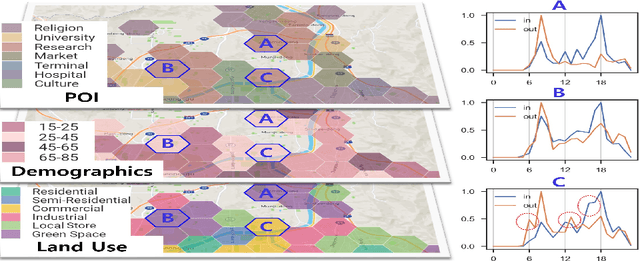
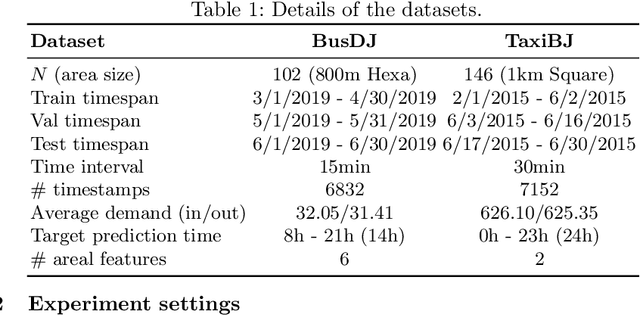
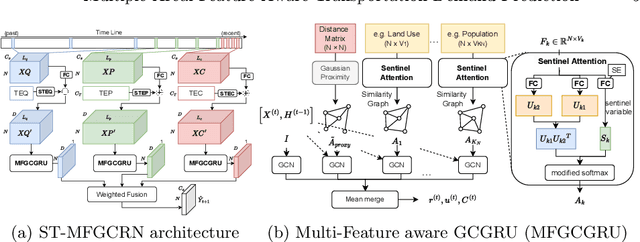
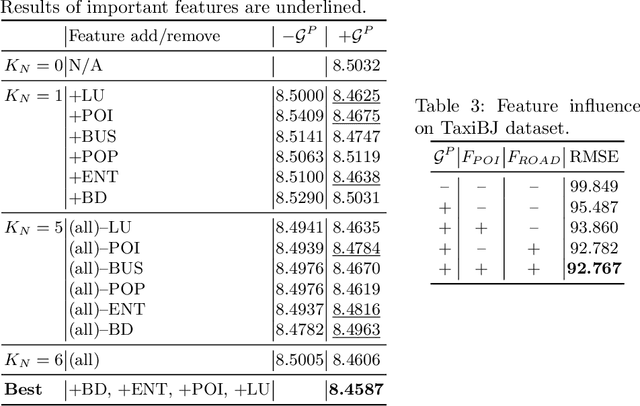
Abstract:A reliable short-term transportation demand prediction supports the authorities in improving the capability of systems by optimizing schedules, adjusting fleet sizes, and generating new transit networks. A handful of research efforts incorporate one or a few areal features while learning spatio-temporal correlation, to capture similar demand patterns between similar areas. However, urban characteristics are polymorphic, and they need to be understood by multiple areal features such as land use, sociodemographics, and place-of-interest (POI) distribution. In this paper, we propose a novel spatio-temporal multi-feature-aware graph convolutional recurrent network (ST-MFGCRN) that fuses multiple areal features during spatio-temproal understanding. Inside ST-MFGCRN, we devise sentinel attention to calculate the areal similarity matrix by allowing each area to take partial attention if the feature is not useful. We evaluate the proposed model on two real-world transportation datasets, one with our constructed BusDJ dataset and one with benchmark TaxiBJ. Results show that our model outperforms the state-of-the-art baselines up to 7\% on BusDJ and 8\% on TaxiBJ dataset.
Neural embedding of beliefs reveals the role of relative dissonance in human decision-making
Aug 13, 2024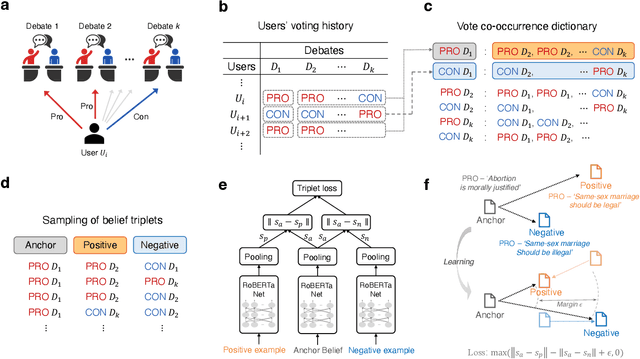
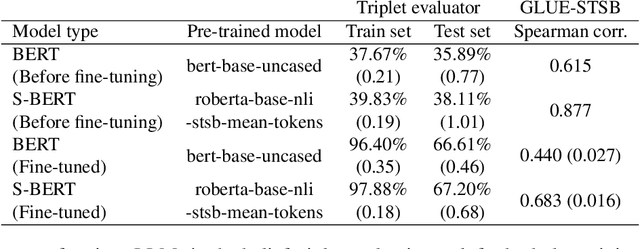
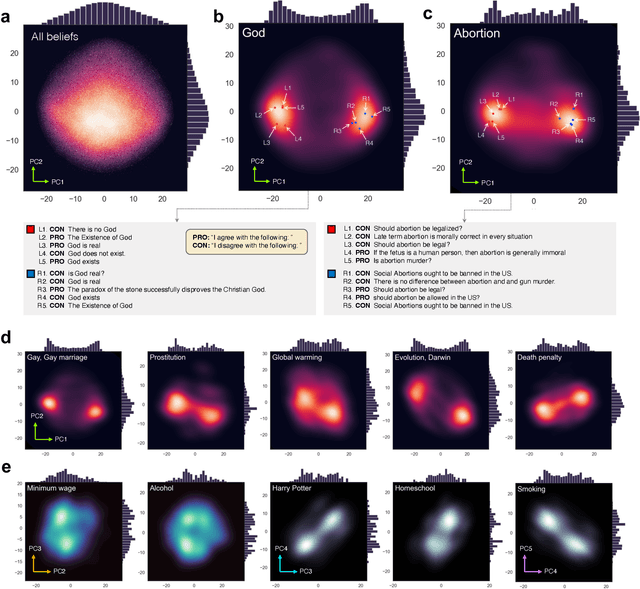
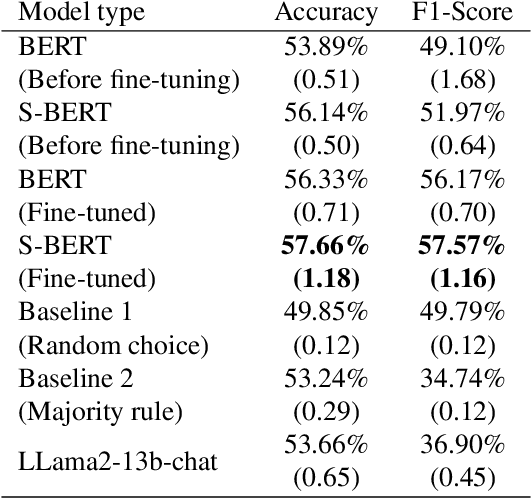
Abstract:Beliefs serve as the foundation for human cognition and decision-making. They guide individuals in deriving meaning from their lives, shaping their behaviors, and forming social connections. Therefore, a model that encapsulates beliefs and their interrelationships is crucial for quantitatively studying the influence of beliefs on our actions. Despite its importance, research on the interplay between human beliefs has often been limited to a small set of beliefs pertaining to specific issues, with a heavy reliance on surveys or experiments. Here, we propose a method for extracting nuanced relations between thousands of beliefs by leveraging large-scale user participation data from an online debate platform and mapping these beliefs to an embedding space using a fine-tuned large language model (LLM). This belief embedding space effectively encapsulates the interconnectedness of diverse beliefs as well as polarization across various social issues. We discover that the positions within this belief space predict new beliefs of individuals. Furthermore, we find that the relative distance between one's existing beliefs and new beliefs can serve as a quantitative estimate of cognitive dissonance, allowing us to predict new beliefs. Our study highlights how modern LLMs, when combined with collective online records of human beliefs, can offer insights into the fundamental principles that govern human belief formation and decision-making processes.
Rematch: Robust and Efficient Matching of Local Knowledge Graphs to Improve Structural and Semantic Similarity
Apr 02, 2024



Abstract:Knowledge graphs play a pivotal role in various applications, such as question-answering and fact-checking. Abstract Meaning Representation (AMR) represents text as knowledge graphs. Evaluating the quality of these graphs involves matching them structurally to each other and semantically to the source text. Existing AMR metrics are inefficient and struggle to capture semantic similarity. We also lack a systematic evaluation benchmark for assessing structural similarity between AMR graphs. To overcome these limitations, we introduce a novel AMR similarity metric, rematch, alongside a new evaluation for structural similarity called RARE. Among state-of-the-art metrics, rematch ranks second in structural similarity; and first in semantic similarity by 1--5 percentage points on the STS-B and SICK-R benchmarks. Rematch is also five times faster than the next most efficient metric.
ChatGPT Rates Natural Language Explanation Quality Like Humans: But on Which Scales?
Mar 26, 2024



Abstract:As AI becomes more integral in our lives, the need for transparency and responsibility grows. While natural language explanations (NLEs) are vital for clarifying the reasoning behind AI decisions, evaluating them through human judgments is complex and resource-intensive due to subjectivity and the need for fine-grained ratings. This study explores the alignment between ChatGPT and human assessments across multiple scales (i.e., binary, ternary, and 7-Likert scale). We sample 300 data instances from three NLE datasets and collect 900 human annotations for both informativeness and clarity scores as the text quality measurement. We further conduct paired comparison experiments under different ranges of subjectivity scores, where the baseline comes from 8,346 human annotations. Our results show that ChatGPT aligns better with humans in more coarse-grained scales. Also, paired comparisons and dynamic prompting (i.e., providing semantically similar examples in the prompt) improve the alignment. This research advances our understanding of large language models' capabilities to assess the text explanation quality in different configurations for responsible AI development.
Benchmarking zero-shot stance detection with FlanT5-XXL: Insights from training data, prompting, and decoding strategies into its near-SoTA performance
Mar 01, 2024



Abstract:We investigate the performance of LLM-based zero-shot stance detection on tweets. Using FlanT5-XXL, an instruction-tuned open-source LLM, with the SemEval 2016 Tasks 6A, 6B, and P-Stance datasets, we study the performance and its variations under different prompts and decoding strategies, as well as the potential biases of the model. We show that the zero-shot approach can match or outperform state-of-the-art benchmarks, including fine-tuned models. We provide various insights into its performance including the sensitivity to instructions and prompts, the decoding strategies, the perplexity of the prompts, and to negations and oppositions present in prompts. Finally, we ensure that the LLM has not been trained on test datasets, and identify a positivity bias which may partially explain the performance differences across decoding strategie
Token-Ensemble Text Generation: On Attacking the Automatic AI-Generated Text Detection
Feb 17, 2024



Abstract:The robustness of AI-content detection models against cultivated attacks (e.g., paraphrasing or word switching) remains a significant concern. This study proposes a novel token-ensemble generation strategy to challenge the robustness of current AI-content detection approaches. We explore the ensemble attack strategy by completing the prompt with the next token generated from random candidate LLMs. We find the token-ensemble approach significantly drops the performance of AI-content detection models (The code and test sets will be released). Our findings reveal that token-ensemble generation poses a vital challenge to current detection models and underlines the need for advancing detection technologies to counter sophisticated adversarial strategies.
Improving Real Estate Appraisal with POI Integration and Areal Embedding
Nov 20, 2023


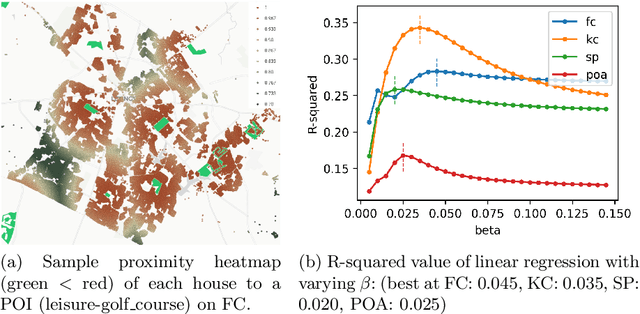
Abstract:Despite advancements in real estate appraisal methods, this study primarily focuses on two pivotal challenges. Firstly, we explore the often-underestimated impact of Points of Interest (POI) on property values, emphasizing the necessity for a comprehensive, data-driven approach to feature selection. Secondly, we integrate road-network-based Areal Embedding to enhance spatial understanding for real estate appraisal. We first propose a revised method for POI feature extraction, and discuss the impact of each POI for house price appraisal. Then we present the Areal embedding-enabled Masked Multihead Attention-based Spatial Interpolation for House Price Prediction (AMMASI) model, an improvement upon the existing ASI model, which leverages masked multi-head attention on geographic neighbor houses and similar-featured houses. Our model outperforms current baselines and also offers promising avenues for future optimization in real estate appraisal methodologies.
Enhancing Stance Classification with Quantified Moral Foundations
Oct 15, 2023



Abstract:This study enhances stance detection on social media by incorporating deeper psychological attributes, specifically individuals' moral foundations. These theoretically-derived dimensions aim to provide a comprehensive profile of an individual's moral concerns which, in recent work, has been linked to behaviour in a range of domains, including society, politics, health, and the environment. In this paper, we investigate how moral foundation dimensions can contribute to predicting an individual's stance on a given target. Specifically we incorporate moral foundation features extracted from text, along with message semantic features, to classify stances at both message- and user-levels across a range of targets and models. Our preliminary results suggest that encoding moral foundations can enhance the performance of stance detection tasks and help illuminate the associations between specific moral foundations and online stances on target topics. The results highlight the importance of considering deeper psychological attributes in stance analysis and underscores the role of moral foundations in guiding online social behavior.
Enhancing Spatiotemporal Traffic Prediction through Urban Human Activity Analysis
Aug 20, 2023
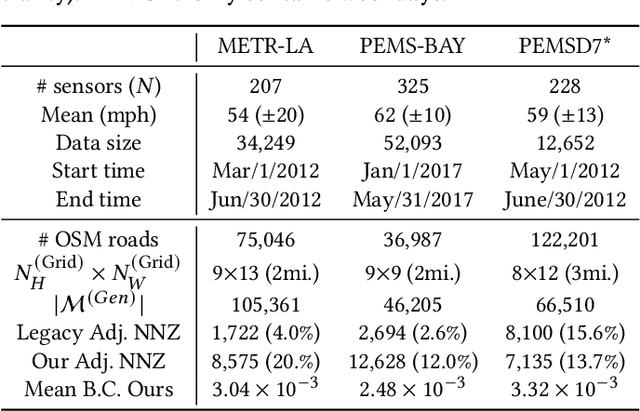

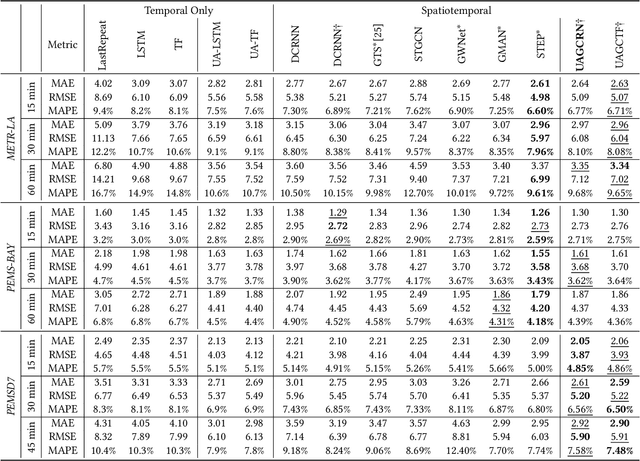
Abstract:Traffic prediction is one of the key elements to ensure the safety and convenience of citizens. Existing traffic prediction models primarily focus on deep learning architectures to capture spatial and temporal correlation. They often overlook the underlying nature of traffic. Specifically, the sensor networks in most traffic datasets do not accurately represent the actual road network exploited by vehicles, failing to provide insights into the traffic patterns in urban activities. To overcome these limitations, we propose an improved traffic prediction method based on graph convolution deep learning algorithms. We leverage human activity frequency data from National Household Travel Survey to enhance the inference capability of a causal relationship between activity and traffic patterns. Despite making minimal modifications to the conventional graph convolutional recurrent networks and graph convolutional transformer architectures, our approach achieves state-of-the-art performance without introducing excessive computational overhead.
 Add to Chrome
Add to Chrome Add to Firefox
Add to Firefox Add to Edge
Add to Edge